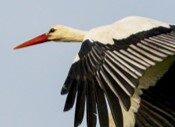Short Communication - Evidence suggests an opportunistic entomophagous diet of the White Stork Ciconia ciconia in Sicily during breeding and post-breeding periods
Salvatore Surdo, Concetta Francesca Zapparrata, Renzo Ientile & Bruno Massa
Abstract:
Insects are known to represent a critical part of the White Stork Ciconia ciconia diet throughout its breeding range. Yet, the composition of the diet in the storks breeding in the Mediterranean regions remains poorly explored. Here, we investigated the diet of a population of white storks from Sicily through pellets collected in 2003, 2007, and 2020. A total of 1,928 prey items were identified and classified into six categories. Insects dominated the diet in all years and represented 99.06% of the whole prey number. Two orders of insects were mainly consumed, namely Orthoptera, which were the most frequent prey, followed by Coleoptera. Within these, carabid beetles were dominant, followed by tenebrionids. Aiming to extend the study of the diet to the post-breeding period, we carried out direct observations on migratory Storks in September 2021, during the migration period. In this period, White Storks were observed feeding in arable lands with high concentration of small crickets Grylloderes brunneri. Altogether, our study provides new insights on the diet of White Storks in the Mediterranean range and highlights how conserving areas that support high diversity of insect species may also favor organisms at higher levels of the trophic chain.

